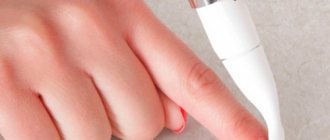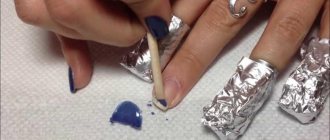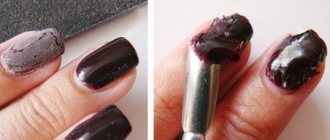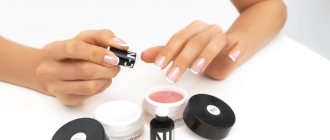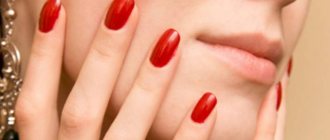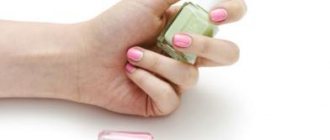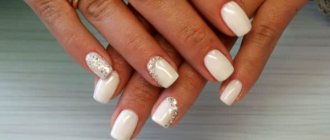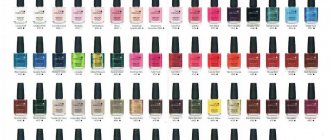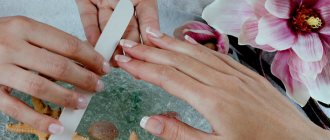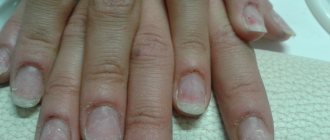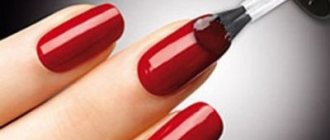Shellac remains on the nails in the same condition for up to a month or more, but gradually it begins to bring discomfort to the girl, which is why she has to learn how to remove shellac at home, since there is not always a desire to visit a salon for this.
Removing shellac at home must be done as carefully as possible, because increased adhesion of the composition to the nail plate complicates manipulations, since the risk of accidental damage to the integrity of the upper stratum corneum of the bed increases.
Removing gel polish or shellac coating
The basis of shellac (Shellac from Creative Nail Design, made in the USA) is a natural resin , thanks to which it is quite durable. Shellac or gel polish can stay on nails for 2 weeks or more. Article - how long does gel polish or shellac last? You need to understand that shellac is just one of the brands of gel polish manufacturers. As Pampers is one of the manufacturers of disposable diapers.
To remove this coating from nails in a salon, use a special product necessary to soften it - Product Remover , or carefully file off the coating with a milling cutter.
The master saturates the sponges with the liquid and places them on the nail plates, after which he wraps the fingertips in foil to secure them. After 10-15 minutes, remove the fingers one by one from the overlays and, using an orange stick, carefully pry off the coating - it easily comes off the nail surface. Otherwise the process is repeated. Irregularities in the nails are removed using a soft file or buff.
Professional products
Safe removal of shellac at home is best done using professional products designed for this purpose. There are 3 categories of solvents for erasing varnish: with acetone, with vitamins and without acetone.
All liquids, regardless of type, act on the following principle: they penetrate the hardened gel and make it soft for subsequent removal.
Removers that exclude acetone contain its substitutes:
- ethyl acetate;
- methyl ethyl ketone;
- amyl acetate
These substances have a delicate effect on the nail, but require longer exposure time and often do not completely remove the coating in one application.
The most popular and affordable means for safely removing gel coating include:
| Means | Description | Production | Price |
| YOKO | The composition contains vitamins A and E, has a simple method of application, and after application it can be quickly removed along with the shellac with a paper napkin. | Production - USA. | Cost – 370 rub. |
| Perfect | Clear composition, easy to use, does not require auxiliary tools. Easily removes the coating within 10-15 minutes. Plus - low cost. | Production - Korea. | Cost – 150 rubles. |
| CND | Professional remover with essential oils and vitamins A, B and E. Gently removes the gel layer without damaging the natural nail. Acts within 5-7 minutes, non-toxic. | Production - Great Britain. | Cost – 1050 rub. |
| Severina | Despite the relatively low cost, the product has a good composition and fast action. The gel coating can be easily wiped off with a cotton pad after use. The downside is the long exposure time. | Production - Russia. | Cost – 270 rubles. |
| Rio Pro | It has a triple effect, softens, degreases and at the same time removes the dispersion layer of the coating. | Production - Russia. | Cost – 190 rub. |
| Beauty Pro | Effective on all types of gel coatings, contains vitamin E, which helps strengthen nails and remove the coating without damaging the plate. | Production - Russia. | Cost – 90 rub. |
| TNL | A low-cost substitute for professional acetone-based products, used to remove gel polish and biogel, acts quickly, removes coating in one application. | Production - South Korea. | Cost – 75 rubles. |
| In Garden | A product for softening and removing acrylic coating and tips from extended nails, used together with foil. | Production - USA. | Cost – 200 rub. |
When choosing a suitable shellac remover, it is important to consider the base on which the coating is applied; different types of products are used for natural and extended nails. Using a steamer or milling cutter will simplify the process and get rid of the gel without damaging your nails.
Methods for removing shellac or gel polish at home
In order to remove shellac from nails at home, you can use both professional liquid and other improvised means . This coating is usually removed using:
- regular nail polish remover;
- soaking nails in nail polish remover or isopropyl alcohol;
- files or buff.
It’s much easier for those who have a special tool. But what if you don’t have it at hand at the right time, and for some reason going to the salon is impossible?
Method number 1: Regular nail polish remover
The special product can be replaced with concentrated liquid for removing regular nail polish. Just pay attention: such a product must contain acetone . Other means will not work - they will not be able to soften the shellac even minimally.
| If there is no such liquid, then pure acetone or isopropyl alcohol will do. But the time that cotton pads soaked in these products remain on the nails is significantly reduced. |
For the removal procedure you need:
- Cotton pads or cotton wool.
- Regular foil, adhesive tape, tape - these will be needed to secure the cotton pads. Some people use polyethylene for these purposes, but it is not very convenient.
- Acetone nail polish remover, acetone or isopropyl alcohol.
- Orange sticks.
- File.
What is the best way to remove shellac at home?
Before you study the detailed instructions and methods for removing the coating, you need to talk about the dangers of manicure dust when removing the gel in the salon. Dust can easily clog the lungs of both the client and the master, after which allergies, bronchitis and much more occur. To prevent anything unnecessary from getting into the lungs, you need to purchase a special hood.
Shellac can be removed in several ways:
Using foil and nail polish remover
How to remove shellac with liquid? Since it is similar in consistency to nail polish, you can use concentrated nail polish remover to remove it from the nail plate. A prerequisite is that the product must contain acetone, which helps soften the shellac.
For the procedure you will need:
- cotton pads;
- foil;
- nail polish remover with acetone;
- wooden or orange stick;
- file or buff.
- Cotton pads are cut into four parts and moistened in liquid with acetone. Each piece is carefully placed on the nail. It is advisable not to touch the skin around the nail plate, so as not to provoke a burn or an allergic reaction. To be safe, lubricate the skin around the nails with a rich cream or oil.
- Foil cut into ten pieces is wrapped around each finger, tightly securing the cotton pad to the nail plate. If you feel that the fixation is insufficient, you can secure it on top with tape or adhesive tape.
- The compress must be kept on the fingers for 10-20 minutes. The exact time depends on the concentration of acetone; the higher it is, the less time is needed.
- After time has passed, it is necessary to remove the foil and cotton pad in the same order as they were applied. If everything was done correctly, you will see that the shellac has lifted a little
- The softened gel must be carefully picked up with a wooden stick and removed from the nail plate. If particles remain on the nail, carefully and without pressing, scrape them off with a stick.
- Complete the procedure by treating the nails with a buff or file.
In the absence of a special liquid, you can use pure acetone. In this case, the duration of exposure under the foil will be reduced.
Using a bath of gel polish remover
How to remove shellac without foil and cotton pads? This method is a little simpler, since you do not have to prepare cotton pads and foil in advance, and then wait 20 minutes for the shellac to come off the nail plate.
For this procedure you will need:
- bath or small container;
- nail polish remover with acetone;
- fatty cream or butter;
- wooden or orange stick;
- buff or file.
- Wash your hands thoroughly before starting the procedure and lubricate your fingers with a rich cream to avoid getting burned.
- Pour the liquid with acetone into the container and dip your fingertips into it.
- Soak the marigolds in the acetone liquid for about eight minutes.
- Carefully remove the softened gel from the nail plate with a wooden stick along with any remaining residue.
- Treat your nails with a buff or file.
- Wash your hands again and apply cream.
While soaking the shellac coating in the bath, pay attention to the condition of your skin; it is better to stop the procedure if you suddenly feel a burning sensation and see redness.
Removal by sawing
How else can you remove shellac polish? Removing gel by filing is a dangerous method, so only the top layer is allowed to be filed so as not to injure the nail plate. For this purpose, you can use a file or a buff with a large coating. You need to cut down very carefully and make sure that the base layer remains in place. It is easy to recognize: it has an opaque beige color.
Also, during filing, particles of manicure dust can enter the lungs. To prevent this from happening, you need to have a hood near your workplace.
How can you remove shellac at home using liquid?
Gel polish remover helps remove the coating from the nail plate in the shortest time due to its composition. In addition to acetone and other aggressive substances, various vitamins, oils, petroleum jelly and glycerin are added to it. Therefore, this method can be called the most gentle: the nail plate receives nutrients that prevent it from becoming thinner.
It is recommended to use liquid to remove shellac coating in the same way as in the first method, that is, you need to make a compress. The main difference will only be in the exposure time - this product softens the gel in 8-10 minutes.
Advantages and disadvantages of home methods for removing shellac
The undoubted advantage of the first method is its low cost - you do not need to spend money on tools and materials, usually they can be found in every home. If you do have to spend money, they will be enough for several withdrawals. The advantages also include saving time - the procedure can be performed without waiting in line to make an appointment at the salon.
There are more disadvantages - some inconvenience is possible (when removing the coating on the right hand, the foil slips, when the nails of the first hand are wrapped in foil, it is difficult to prepare the other), an increase in the duration of the procedure up to an hour - when treating hands alternately, the risk of injury to the nail when using metal tools, or skin, exposure to a fairly aggressive liquid on the nails.
The advantage of soaking nails in nail polish remover or isopropyl alcohol is the speed of the procedure , the ability to observe the destruction of shellac and control the process. A significant disadvantage is the aggressive effect of the liquid on the skin and nail surface (drying), as well as possible injury to the nail surface when removing shellac with a metal pusher.
Cutting the shellac coating down to the base layer has its advantages - saving time, the ability to immediately apply a new coating. But with all this, you can touch or inadvertently cut off the entire top layer of the nail plate , thereby injuring and thinning it.
Removing shellac coating with a special liquid has more advantages than disadvantages. The first include the minimum time spent, the presence in such a product of components that can have a positive effect on the nail surface. The only disadvantages include possible inconvenience when removing the coating from nails yourself, and the risk of damage to the nail plate if you use the pusher carelessly.
Benefits of removing shellac in a salon
The most significant advantages of the procedure done in the salon are the shortening of the duration of the process due to the use of professional liquid, eliminating the risk of injury to the nail plates, complete removal of shellac without the remainder of a microscopic film. The specialist can also select suitable care products for the nails after removal.
Differences between shellac and gel polish
Often the word “shellac” refers not only to the gel coating produced by CND , but also to other gel polishes. This definition is erroneous, since these products differ from each other in composition, consistency and properties.
Main differences:
- before applying shellac, the nails are treated with a degreasing agent; before applying gel polish, the nails are treated with a primer and the top layer is removed from the nail plate;
- Unlike gel polish, shellac does not contain harmful components such as formaldehyde and toluene;
- removing the shellac coating is quite simple - you just need to use a special liquid, but gel polish must first be filed down, and then use a liquid with an acetone base;
- shellac is more durable, but more expensive than gel polish.
| To remove shellac, it is best to use a remover from the same manufacturer. |
With all the convenience of shellac and gel polish coating, you should not forget to give your nails a rest. Therefore, you need to take breaks between coating applications ; they should be 10-14 days.
Is it possible to remove shellac with a file?
Often girls ask, is it possible to remove shellac themselves with a file? Of course you can. This is approximately the same method as with the device, but you just have to do everything manually. Just choose the file correctly. Its abrasiveness should be 150 grit, that is, medium hardness. The file is rough and this makes it possible to quickly remove the coating. Again, remember to be careful not to damage your nails.
To file, it is important to move along the nail correctly. The pressure should be medium and soft around the cuticle.
Restoring nail plates after shellac removal
Often, after removing the shellac coating, it is discovered that the nail plates have weakened and become thinner. This means that a break is necessary, during which the nails are not treated with wellness treatments. During such periods, it is better to give the nail plates a rest and avoid applying even ordinary varnishes.
There are a huge number of simple bath recipes for strengthening thin nails . Some of them:
Add 1 tbsp to 100 ml of warm water. l. sea salt and 5-6 drops of iodine. You need to keep your nails in this bath for about 20 minutes, then dry them and apply a rich cream.
Bath with essential oils . You will need 250 ml of warm water, sea salt - 1 tbsp. l., grapefruit, tea tree and cedar oil - 1 drop each. Mix all the components, keep the nails in the resulting liquid for 10-15 minutes, then dry them and use a cream to moisturize or nourish the skin.
In order to strengthen the nail plates, you can use oils: almond, lemon, eucalyptus, chamomile, rosemary, sandalwood, apricot. To restore the structure of nails, you need to use oils: geranium, rosehip, tangerine, avocado. To get rid of yellowish nail plates, using lemon oil is effective .
| General healing properties of essential oils for nails: help accelerate their growth, soften the cuticle, give them a uniform color and shine. |
Thus, to safely remove shellac at home, it is necessary to follow the technology for removing this coating and not carry out manipulations that could damage the nail plate. Don’t forget about periodic restorative procedures for nails.
Useful tips
- Be extremely careful with acetone-containing liquids. Avoid contact with skin and cuticles, mucous membranes and eyes.
- It is not recommended to use technical acetone to remove shellac. Its aggressive effects can dry out and damage the nail plate.
- Don't skimp on a quality shellac remover. It will allow you to carefully clean your nails and save time. A professional remover lasts from 5 to 8 minutes.
- Resist the temptation to speed up the process and cut off all the varnish or rip off the coating. This is extremely damaging to the nail.
Professional remover
